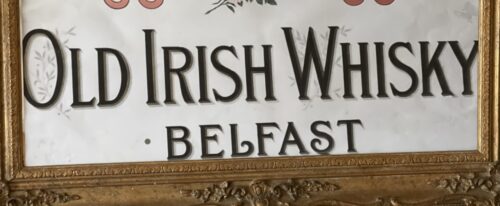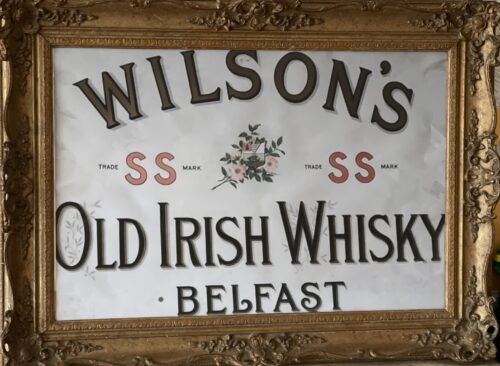-
Out of stock
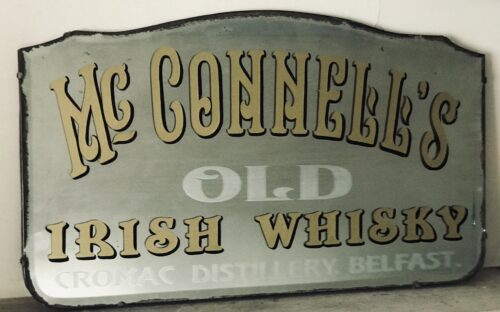
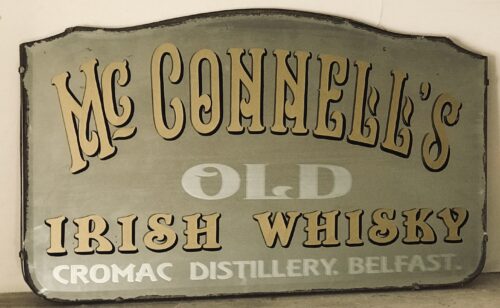 Fantastic McConnell's Old Irish Whiskey Mirror (Cromac Distillery Belfast)-McConnell's closed in 1930 so we estimate this mirror to be approximately 95-110 years old.Please email us for further details and pricing. 40cm x 70cm Portadown Co Armagh (Please note that all of our rare, expensive mirrors are packed,protected and secured with the utmost care and are shipped via DHL in specially constructed plywood transport containers )In 1776 Two brothers, John and James, from Northern Ireland began to produce a whisky celebrated for its exceptional smoothness and taste: J. & J. McConnell. McConnell’s quickly became the toast of Belfast,was shipped to all corners of the globe, helping to establish Irish whisky as the most popular drink in the world. The McConnell’s distillery was right on the banks of River Lagan, a sprawling, buzzing compound dedicated to one pursuit: producing the finest whisky in all of Ireland. Then on one fateful day in 1909, 500,000 gallons of McConnell’s whisky went up in flames and by the time it was over, half the distillery lay in ruins.This would have been the end for most whiskies. But not McConnell’s. They began to rebuild. Before long, they were back on top of the Irish whisky world. But then calamity struck again. This time it wasn’t a fire – it was Prohibition, which outlawed the sale of liquor in the United States.America was the biggest market for Irish whisky, and suddenly it was gone. Ninety percent of Irish whiskies went under as a result of Prohibition, including McConnell’s.
Fantastic McConnell's Old Irish Whiskey Mirror (Cromac Distillery Belfast)-McConnell's closed in 1930 so we estimate this mirror to be approximately 95-110 years old.Please email us for further details and pricing. 40cm x 70cm Portadown Co Armagh (Please note that all of our rare, expensive mirrors are packed,protected and secured with the utmost care and are shipped via DHL in specially constructed plywood transport containers )In 1776 Two brothers, John and James, from Northern Ireland began to produce a whisky celebrated for its exceptional smoothness and taste: J. & J. McConnell. McConnell’s quickly became the toast of Belfast,was shipped to all corners of the globe, helping to establish Irish whisky as the most popular drink in the world. The McConnell’s distillery was right on the banks of River Lagan, a sprawling, buzzing compound dedicated to one pursuit: producing the finest whisky in all of Ireland. Then on one fateful day in 1909, 500,000 gallons of McConnell’s whisky went up in flames and by the time it was over, half the distillery lay in ruins.This would have been the end for most whiskies. But not McConnell’s. They began to rebuild. Before long, they were back on top of the Irish whisky world. But then calamity struck again. This time it wasn’t a fire – it was Prohibition, which outlawed the sale of liquor in the United States.America was the biggest market for Irish whisky, and suddenly it was gone. Ninety percent of Irish whiskies went under as a result of Prohibition, including McConnell’s. -
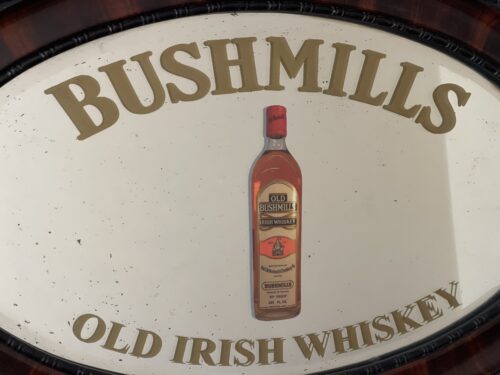
 83cm x 53cm Bushmills is officially the worlds oldest whiskey distillery- when in 1608 King James I granted Sir Thomas Phillips,landowner and Governor of Co Antrim,Ireland - a licence to distill.It was in 1784 when Mr Hugh Anderson registered the Old Bushmills Distillery and the Pot Still became its registered trademark, which is still a mark of genuine distinction to this day. The Bushmills area has a long tradition with distillation. According to one story, as far back as 1276, an early settler called Sir Robert Savage of Ards, before defeating the Irish in battle, fortified his troops with "a mighty drop of acqua vitae". In 1608, a licence was granted to Sir Thomas Phillips (Irish adventurer) by King James I to distil whiskey. The Bushmills Old Distillery Company itself was not established until 1784 by Hugh Anderson. Bushmills suffered many lean years with numerous periods of closure with no record of the distillery being in operation in the official records both in 1802 and in 1822. In 1860 a Belfast spirit merchant named Jame McColgan and Patrick Corrigan bought the distillery; in 1880 they formed a limited company. In 1885, the original Bushmills buildings were destroyed by fire but the distillery was swiftly rebuilt. In 1890, a steamship owned and operated by the distillery, SS Bushmills, made its maiden voyage across the Atlantic to deliver Bushmills whiskey to America. It called at Philadelphiaand New York City before heading on to Singapore, Hong Kong, Shanghai and Yokohama.In the early 20th century, the U.S. was a very important market for Bushmills (and other Irish Whiskey producers). American Prohibition in 1920 came as a large blow to the Irish Whiskey industry, but Bushmills managed to survive. Wilson Boyd, Bushmills' director at the time, predicted the end of prohibition and had large stores of whiskey ready to export. After the Second World War, the distillery was bought by Isaac Wolfson, and, in 1972, it was taken over by Irish Distillers, meaning that Irish Distillers controlled the production of all Irish whiskey at the time. In June 1988, Irish Distillers was bought by French liquor group Pernod Ricard.In June 2005, the distillery was bought by Diageo for £200 million. Diageo have also announced a large advertising campaign in order to regain a market share for Bushmills.In May 2008, the Bank of Ireland issued a new series of sterling banknotes in Northern Ireland which all feature an illustration of the Old Bushmills Distillery on the obverse side, replacing the previous notes series which depicted Queen's University of Belfast. In November 2014 it was announced that Diageo had traded the Bushmills brand with Jose Cuervo in exchange for the 50% of the Don Julio brand of tequila that Diageo did not already own.
83cm x 53cm Bushmills is officially the worlds oldest whiskey distillery- when in 1608 King James I granted Sir Thomas Phillips,landowner and Governor of Co Antrim,Ireland - a licence to distill.It was in 1784 when Mr Hugh Anderson registered the Old Bushmills Distillery and the Pot Still became its registered trademark, which is still a mark of genuine distinction to this day. The Bushmills area has a long tradition with distillation. According to one story, as far back as 1276, an early settler called Sir Robert Savage of Ards, before defeating the Irish in battle, fortified his troops with "a mighty drop of acqua vitae". In 1608, a licence was granted to Sir Thomas Phillips (Irish adventurer) by King James I to distil whiskey. The Bushmills Old Distillery Company itself was not established until 1784 by Hugh Anderson. Bushmills suffered many lean years with numerous periods of closure with no record of the distillery being in operation in the official records both in 1802 and in 1822. In 1860 a Belfast spirit merchant named Jame McColgan and Patrick Corrigan bought the distillery; in 1880 they formed a limited company. In 1885, the original Bushmills buildings were destroyed by fire but the distillery was swiftly rebuilt. In 1890, a steamship owned and operated by the distillery, SS Bushmills, made its maiden voyage across the Atlantic to deliver Bushmills whiskey to America. It called at Philadelphiaand New York City before heading on to Singapore, Hong Kong, Shanghai and Yokohama.In the early 20th century, the U.S. was a very important market for Bushmills (and other Irish Whiskey producers). American Prohibition in 1920 came as a large blow to the Irish Whiskey industry, but Bushmills managed to survive. Wilson Boyd, Bushmills' director at the time, predicted the end of prohibition and had large stores of whiskey ready to export. After the Second World War, the distillery was bought by Isaac Wolfson, and, in 1972, it was taken over by Irish Distillers, meaning that Irish Distillers controlled the production of all Irish whiskey at the time. In June 1988, Irish Distillers was bought by French liquor group Pernod Ricard.In June 2005, the distillery was bought by Diageo for £200 million. Diageo have also announced a large advertising campaign in order to regain a market share for Bushmills.In May 2008, the Bank of Ireland issued a new series of sterling banknotes in Northern Ireland which all feature an illustration of the Old Bushmills Distillery on the obverse side, replacing the previous notes series which depicted Queen's University of Belfast. In November 2014 it was announced that Diageo had traded the Bushmills brand with Jose Cuervo in exchange for the 50% of the Don Julio brand of tequila that Diageo did not already own.- Bushmills Original – Irish whiskey blend sometimes called White Bush or Bushmills White Label. The grain whiskey is matured in American oak casks.
- Black Bush – A blend with a significantly greater proportion of malt whiskey than the white label. It features malt whiskey aged in casks previously used for Spanish Oloroso sherry.
- Red Bush – Like the Black Bush, this is a blend with a higher proportion of malt whiskey than the standard bottling, but in contrast the malt whiskey has been matured in ex-bourbon casks.
- Bushmills 10 year single malt – Combines malt whiskeys aged at least 10 years in American bourbon or Oloroso sherry casks.
- Bushmills Distillery Reserve 12 year single malt – exclusively available at the Old Bushmills Distillery, this 12 year aged single malt is matured in oak casks for a rich, complex flavour with notes of sherry, dark chocolate and spices.
- Bushmills 16 year single malt – Malt whiskeys aged at least 16 years in American bourbon barrels or Spanish Oloroso sherry butts are mixed together before finishing in Port pipes for a few months.
- Bushmills 21 year single malt – A limited number of 21 year bottles are made each year. After 19 years, bourbon-barrel-aged and sherry-cask-aged malt whiskeys are combined, which is followed by two years of finishing in Madeira drums.
- Bushmills 1608: Originally released as a special 400th Anniversary whiskey; since 2009 it will be available only in the Whiskey Shop at the distillery and at duty-free shops.
-
Out of stock

 Large but gracious Mitchell’s of Belfast Old Irish Whiskey mirror with beautifully bevelled glass bordering. 65cm x 90cm Once a giant of the distilling business along with Dunvilles,Mitchell’s fall from grace, like so many other superb Irish distilleries was symptomatic of the economic climate and circumstances of the time. Charles William Mitchell originated from Scotland and took over his fathers distillery in the Campletown area .In the 1860s he moved to Belfast and became manager of Dunvilles Whiskey before establishing his own brand Mitchell & Co tomb St in the late 1860s.A newspaper report in 1895 hailed the virtues of Mitchells Cruiskeen Lawn Whisky,which secured prizes around the world including first place at the New Orleans Exposition.It was a rare Mitchells Cruiskeen Lawn Whiskey mirror that recently commanded £11500 at auction in 2018 following the sale of the contents of an old Donegal public house. Indeed Mitchell’s were renowned for advertising their products on mirrors, trade cards, minature atlas books and pottery to name just a few. Below is the original mirror that was commissioned for their Tomb Street premises on the launch of their Cruiskeen Lawn Old Irish Whisky, late 1800’s. Two were made for the entrance of their Tomb Street premises. Inscribed is the Cruiskeen Lawn poem, with gold leaf barley with green and red in the Mitchell Crest. Definately the holy grail of all mirrors, a true treasure and still survives today in the heart of Belfast and worth the above mentioned princely sum and now probably more !
Large but gracious Mitchell’s of Belfast Old Irish Whiskey mirror with beautifully bevelled glass bordering. 65cm x 90cm Once a giant of the distilling business along with Dunvilles,Mitchell’s fall from grace, like so many other superb Irish distilleries was symptomatic of the economic climate and circumstances of the time. Charles William Mitchell originated from Scotland and took over his fathers distillery in the Campletown area .In the 1860s he moved to Belfast and became manager of Dunvilles Whiskey before establishing his own brand Mitchell & Co tomb St in the late 1860s.A newspaper report in 1895 hailed the virtues of Mitchells Cruiskeen Lawn Whisky,which secured prizes around the world including first place at the New Orleans Exposition.It was a rare Mitchells Cruiskeen Lawn Whiskey mirror that recently commanded £11500 at auction in 2018 following the sale of the contents of an old Donegal public house. Indeed Mitchell’s were renowned for advertising their products on mirrors, trade cards, minature atlas books and pottery to name just a few. Below is the original mirror that was commissioned for their Tomb Street premises on the launch of their Cruiskeen Lawn Old Irish Whisky, late 1800’s. Two were made for the entrance of their Tomb Street premises. Inscribed is the Cruiskeen Lawn poem, with gold leaf barley with green and red in the Mitchell Crest. Definately the holy grail of all mirrors, a true treasure and still survives today in the heart of Belfast and worth the above mentioned princely sum and now probably more !Description

Reverse side of print






-
Out of stock

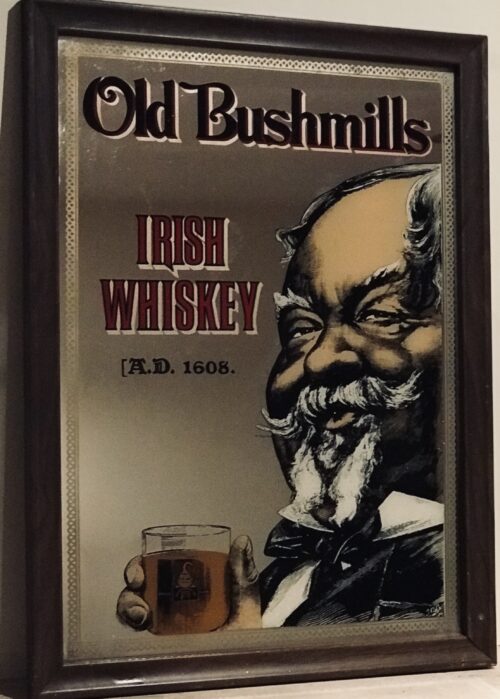 Classic old Bushmills Irish Whiskey Mirror-Est 1608-with the ubiquitous smiling gentleman. 60cm x 45cm Belfast Bushmills is officially the worlds oldest whiskey distillery- when in 1608 King James I granted Sir Thomas Phillips,landowner and Governor of Co Antrim,Ireland - a licence to distill.It was in 1784 when Mr Hugh Anderson registered the Old Bushmills Distillery and the Pot Still became its registered trademark, which is still a mark of genuine distinction to this day. The Bushmills area has a long tradition with distillation. According to one story, as far back as 1276, an early settler called Sir Robert Savage of Ards, before defeating the Irish in battle, fortified his troops with "a mighty drop of acqua vitae". In 1608, a licence was granted to Sir Thomas Phillips (Irish adventurer) by King James I to distil whiskey. The Bushmills Old Distillery Company itself was not established until 1784 by Hugh Anderson. Bushmills suffered many lean years with numerous periods of closure with no record of the distillery being in operation in the official records both in 1802 and in 1822. In 1860 a Belfast spirit merchant named Jame McColgan and Patrick Corrigan bought the distillery; in 1880 they formed a limited company. In 1885, the original Bushmills buildings were destroyed by fire but the distillery was swiftly rebuilt. In 1890, a steamship owned and operated by the distillery, SS Bushmills, made its maiden voyage across the Atlantic to deliver Bushmills whiskey to America. It called at Philadelphiaand New York City before heading on to Singapore, Hong Kong, Shanghai and Yokohama.In the early 20th century, the U.S. was a very important market for Bushmills (and other Irish Whiskey producers). American Prohibition in 1920 came as a large blow to the Irish Whiskey industry, but Bushmills managed to survive. Wilson Boyd, Bushmills' director at the time, predicted the end of prohibition and had large stores of whiskey ready to export. After the Second World War, the distillery was bought by Isaac Wolfson, and, in 1972, it was taken over by Irish Distillers, meaning that Irish Distillers controlled the production of all Irish whiskey at the time. In June 1988, Irish Distillers was bought by French liquor group Pernod Ricard.In June 2005, the distillery was bought by Diageo for £200 million. Diageo have also announced a large advertising campaign in order to regain a market share for Bushmills.In May 2008, the Bank of Ireland issued a new series of sterling banknotes in Northern Ireland which all feature an illustration of the Old Bushmills Distillery on the obverse side, replacing the previous notes series which depicted Queen's University of Belfast. In November 2014 it was announced that Diageo had traded the Bushmills brand with Jose Cuervo in exchange for the 50% of the Don Julio brand of tequila that Diageo did not already own.
Classic old Bushmills Irish Whiskey Mirror-Est 1608-with the ubiquitous smiling gentleman. 60cm x 45cm Belfast Bushmills is officially the worlds oldest whiskey distillery- when in 1608 King James I granted Sir Thomas Phillips,landowner and Governor of Co Antrim,Ireland - a licence to distill.It was in 1784 when Mr Hugh Anderson registered the Old Bushmills Distillery and the Pot Still became its registered trademark, which is still a mark of genuine distinction to this day. The Bushmills area has a long tradition with distillation. According to one story, as far back as 1276, an early settler called Sir Robert Savage of Ards, before defeating the Irish in battle, fortified his troops with "a mighty drop of acqua vitae". In 1608, a licence was granted to Sir Thomas Phillips (Irish adventurer) by King James I to distil whiskey. The Bushmills Old Distillery Company itself was not established until 1784 by Hugh Anderson. Bushmills suffered many lean years with numerous periods of closure with no record of the distillery being in operation in the official records both in 1802 and in 1822. In 1860 a Belfast spirit merchant named Jame McColgan and Patrick Corrigan bought the distillery; in 1880 they formed a limited company. In 1885, the original Bushmills buildings were destroyed by fire but the distillery was swiftly rebuilt. In 1890, a steamship owned and operated by the distillery, SS Bushmills, made its maiden voyage across the Atlantic to deliver Bushmills whiskey to America. It called at Philadelphiaand New York City before heading on to Singapore, Hong Kong, Shanghai and Yokohama.In the early 20th century, the U.S. was a very important market for Bushmills (and other Irish Whiskey producers). American Prohibition in 1920 came as a large blow to the Irish Whiskey industry, but Bushmills managed to survive. Wilson Boyd, Bushmills' director at the time, predicted the end of prohibition and had large stores of whiskey ready to export. After the Second World War, the distillery was bought by Isaac Wolfson, and, in 1972, it was taken over by Irish Distillers, meaning that Irish Distillers controlled the production of all Irish whiskey at the time. In June 1988, Irish Distillers was bought by French liquor group Pernod Ricard.In June 2005, the distillery was bought by Diageo for £200 million. Diageo have also announced a large advertising campaign in order to regain a market share for Bushmills.In May 2008, the Bank of Ireland issued a new series of sterling banknotes in Northern Ireland which all feature an illustration of the Old Bushmills Distillery on the obverse side, replacing the previous notes series which depicted Queen's University of Belfast. In November 2014 it was announced that Diageo had traded the Bushmills brand with Jose Cuervo in exchange for the 50% of the Don Julio brand of tequila that Diageo did not already own.- Bushmills Original – Irish whiskey blend sometimes called White Bush or Bushmills White Label. The grain whiskey is matured in American oak casks.
- Black Bush – A blend with a significantly greater proportion of malt whiskey than the white label. It features malt whiskey aged in casks previously used for Spanish Oloroso sherry.
- Red Bush – Like the Black Bush, this is a blend with a higher proportion of malt whiskey than the standard bottling, but in contrast the malt whiskey has been matured in ex-bourbon casks.
- Bushmills 10 year single malt – Combines malt whiskeys aged at least 10 years in American bourbon or Oloroso sherry casks.
- Bushmills Distillery Reserve 12 year single malt – exclusively available at the Old Bushmills Distillery, this 12 year aged single malt is matured in oak casks for a rich, complex flavour with notes of sherry, dark chocolate and spices.
- Bushmills 16 year single malt – Malt whiskeys aged at least 16 years in American bourbon barrels or Spanish Oloroso sherry butts are mixed together before finishing in Port pipes for a few months.
- Bushmills 21 year single malt – A limited number of 21 year bottles are made each year. After 19 years, bourbon-barrel-aged and sherry-cask-aged malt whiskeys are combined, which is followed by two years of finishing in Madeira drums.
- Bushmills 1608: Originally released as a special 400th Anniversary whiskey; since 2009 it will be available only in the Whiskey Shop at the distillery and at duty-free shops.
-

 Beautifully illustrated and ornate medium sized Bushmills mirror-making an excellent collectors item. 40cm x 50cm Clones Co Monaghan Bushmills is officially the worlds oldest whiskey distillery- when in 1608 King James I granted Sir Thomas Phillips,landowner and Governor of Co Antrim,Ireland - a licence to distill.It was in 1784 when Mr Hugh Anderson registered the Old Bushmills Distillery and the Pot Still became its registered trademark, which is still a mark of genuine distinction to this day. The Bushmills area has a long tradition with distillation. According to one story, as far back as 1276, an early settler called Sir Robert Savage of Ards, before defeating the Irish in battle, fortified his troops with "a mighty drop of acqua vitae". In 1608, a licence was granted to Sir Thomas Phillips (Irish adventurer) by King James I to distil whiskey. The Bushmills Old Distillery Company itself was not established until 1784 by Hugh Anderson. Bushmills suffered many lean years with numerous periods of closure with no record of the distillery being in operation in the official records both in 1802 and in 1822. In 1860 a Belfast spirit merchant named Jame McColgan and Patrick Corrigan bought the distillery; in 1880 they formed a limited company. In 1885, the original Bushmills buildings were destroyed by fire but the distillery was swiftly rebuilt. In 1890, a steamship owned and operated by the distillery, SS Bushmills, made its maiden voyage across the Atlantic to deliver Bushmills whiskey to America. It called at Philadelphiaand New York City before heading on to Singapore, Hong Kong, Shanghai and Yokohama.In the early 20th century, the U.S. was a very important market for Bushmills (and other Irish Whiskey producers). American Prohibition in 1920 came as a large blow to the Irish Whiskey industry, but Bushmills managed to survive. Wilson Boyd, Bushmills' director at the time, predicted the end of prohibition and had large stores of whiskey ready to export. After the Second World War, the distillery was bought by Isaac Wolfson, and, in 1972, it was taken over by Irish Distillers, meaning that Irish Distillers controlled the production of all Irish whiskey at the time. In June 1988, Irish Distillers was bought by French liquor group Pernod Ricard.In June 2005, the distillery was bought by Diageo for £200 million. Diageo have also announced a large advertising campaign in order to regain a market share for Bushmills.In May 2008, the Bank of Ireland issued a new series of sterling banknotes in Northern Ireland which all feature an illustration of the Old Bushmills Distillery on the obverse side, replacing the previous notes series which depicted Queen's University of Belfast. In November 2014 it was announced that Diageo had traded the Bushmills brand with Jose Cuervo in exchange for the 50% of the Don Julio brand of tequila that Diageo did not already own.
Beautifully illustrated and ornate medium sized Bushmills mirror-making an excellent collectors item. 40cm x 50cm Clones Co Monaghan Bushmills is officially the worlds oldest whiskey distillery- when in 1608 King James I granted Sir Thomas Phillips,landowner and Governor of Co Antrim,Ireland - a licence to distill.It was in 1784 when Mr Hugh Anderson registered the Old Bushmills Distillery and the Pot Still became its registered trademark, which is still a mark of genuine distinction to this day. The Bushmills area has a long tradition with distillation. According to one story, as far back as 1276, an early settler called Sir Robert Savage of Ards, before defeating the Irish in battle, fortified his troops with "a mighty drop of acqua vitae". In 1608, a licence was granted to Sir Thomas Phillips (Irish adventurer) by King James I to distil whiskey. The Bushmills Old Distillery Company itself was not established until 1784 by Hugh Anderson. Bushmills suffered many lean years with numerous periods of closure with no record of the distillery being in operation in the official records both in 1802 and in 1822. In 1860 a Belfast spirit merchant named Jame McColgan and Patrick Corrigan bought the distillery; in 1880 they formed a limited company. In 1885, the original Bushmills buildings were destroyed by fire but the distillery was swiftly rebuilt. In 1890, a steamship owned and operated by the distillery, SS Bushmills, made its maiden voyage across the Atlantic to deliver Bushmills whiskey to America. It called at Philadelphiaand New York City before heading on to Singapore, Hong Kong, Shanghai and Yokohama.In the early 20th century, the U.S. was a very important market for Bushmills (and other Irish Whiskey producers). American Prohibition in 1920 came as a large blow to the Irish Whiskey industry, but Bushmills managed to survive. Wilson Boyd, Bushmills' director at the time, predicted the end of prohibition and had large stores of whiskey ready to export. After the Second World War, the distillery was bought by Isaac Wolfson, and, in 1972, it was taken over by Irish Distillers, meaning that Irish Distillers controlled the production of all Irish whiskey at the time. In June 1988, Irish Distillers was bought by French liquor group Pernod Ricard.In June 2005, the distillery was bought by Diageo for £200 million. Diageo have also announced a large advertising campaign in order to regain a market share for Bushmills.In May 2008, the Bank of Ireland issued a new series of sterling banknotes in Northern Ireland which all feature an illustration of the Old Bushmills Distillery on the obverse side, replacing the previous notes series which depicted Queen's University of Belfast. In November 2014 it was announced that Diageo had traded the Bushmills brand with Jose Cuervo in exchange for the 50% of the Don Julio brand of tequila that Diageo did not already own.- Bushmills Original – Irish whiskey blend sometimes called White Bush or Bushmills White Label. The grain whiskey is matured in American oak casks.
- Black Bush – A blend with a significantly greater proportion of malt whiskey than the white label. It features malt whiskey aged in casks previously used for Spanish Oloroso sherry.
- Red Bush – Like the Black Bush, this is a blend with a higher proportion of malt whiskey than the standard bottling, but in contrast the malt whiskey has been matured in ex-bourbon casks.
- Bushmills 10 year single malt – Combines malt whiskeys aged at least 10 years in American bourbon or Oloroso sherry casks.
- Bushmills Distillery Reserve 12 year single malt – exclusively available at the Old Bushmills Distillery, this 12 year aged single malt is matured in oak casks for a rich, complex flavour with notes of sherry, dark chocolate and spices.
- Bushmills 16 year single malt – Malt whiskeys aged at least 16 years in American bourbon barrels or Spanish Oloroso sherry butts are mixed together before finishing in Port pipes for a few months.
- Bushmills 21 year single malt – A limited number of 21 year bottles are made each year. After 19 years, bourbon-barrel-aged and sherry-cask-aged malt whiskeys are combined, which is followed by two years of finishing in Madeira drums.
- Bushmills 1608: Originally released as a special 400th Anniversary whiskey; since 2009 it will be available only in the Whiskey Shop at the distillery and at duty-free shops.
-
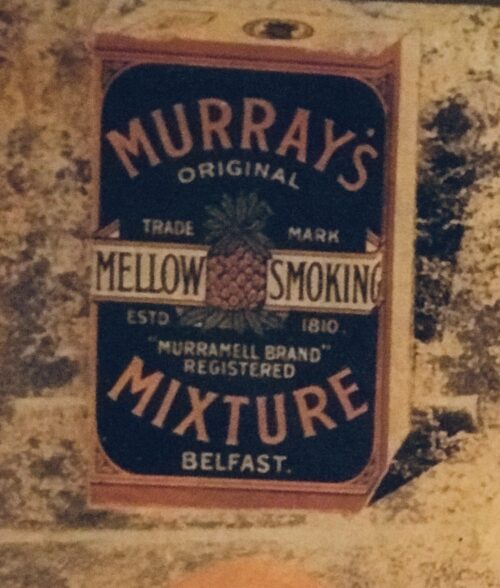
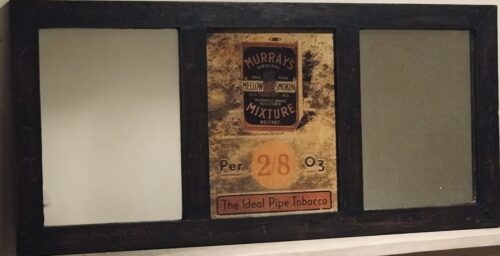 Murrays Original Pipe Strength Tobacco Advertising Mirror- Belfast 100cm x 50cm Murray, Sons and Company Ltd was a tobacco manufacturing company based in Belfast, Northern Ireland. The company traded under its own name but under various ownerships, from its foundation in 1810 until closure in 2005.
Murrays Original Pipe Strength Tobacco Advertising Mirror- Belfast 100cm x 50cm Murray, Sons and Company Ltd was a tobacco manufacturing company based in Belfast, Northern Ireland. The company traded under its own name but under various ownerships, from its foundation in 1810 until closure in 2005.History
Murray, Sons and Company Ltd began trading in Belfast in 1810, and became a limited company in 1884.By 1921, it shared most of the Belfast manufacture of tobacco, cigarettes and snuff with Gallaher Limited, who had moved to Belfast in 1867. Dunlop McCosh Cunningham took over the running of the works in the mid-1920s from his uncle. The firm produced the Erinmore and Yachtsman Navy Cut brands, though the cigarettes were not the superior quality that the pipe tobacco proved to be. The firm produced high quality popular pipe tobacco. For a time in the 1970s the Managing Director was Belfast man Mr Gleghorne and his personal assistant was Mrs Elizabeth Iris McDowell (née Hillock)Acquisition
In 1953, Murray, Sons and Company Ltd was acquired from Dunlop McCosh Cunningham by London-based Carreras Tobacco, which following the sale of shares in 1958 by the Baron family, merged with Rothman's of Pall Mall to become Carreras Rothmans Limited. Carreras Rothmans became known as Rothmans International in 1972. In June 1999, Rothmans International was acquired by British American Tobacco.Closure
In 2004, British American Tobacco announced the possible closure of Murray, Sons and Company Ltd and began a consultation process to review the plant's future. The company's fate was announced in January 2005, with the loss of 63 jobs.Brands
Throughout its trading life, Murray Sons and Company Ltd manufactured various brands of tobacco products including pipe tobacco:[5]- Craven
- Dunhill
- Erinmore
- Yachtsman Navy Cut
-

 85cm x 45cm Dingle Co Kerry The Gaelic Athletic Association-Gaelic Players' Association All Stars Awards (often known simply as the All Stars) are awarded annually to the best player in each of the 15 playing positions in Gaelic football and hurling. Additionally, one player in each code is selected as Player of the Year. The awards have since 2011 been presented jointly by the Gaelic Athletic Association and the representative body for inter-county players, the Gaelic Players Association. Each player who receives a nomination is given a medallion marking the milestone.These are considered to be "the most coveted sporting award scheme in the country".Since the 1960s there had been a tradition of annually selecting the best player in each position, in football and hurling, to create a special team of the year. Between 1963 and 1967 these players received what was known as the Cú Chulainn award. In 1971 these awards were formalised into the annual GAA All Star Awards. In 2006 the Gaelic Players Association launched a parallel award scheme entitled the GPA Gaelic Team of the Year (often referred to as the GPA Awards). An annual award was also given by the GPA to the Footballer of the Year and the Hurler of the Year. In 2011 it was announced that the GAA All Stars Awards, which had been sponsored in recent years by Vodafone, and the GPA Awards would merge under the sponsorship of car manufacturer Opel. The move announced by Christy Cooney saw the achievements of players recognised jointly for the first time in October 2011. The All Stars team comprises the best player in each position, regardless of club or county affiliation. The composition of the All Star teams are decided on the basis of a shortlist compiled by a selection committee of sports journalists from the national media, while the overall winners are chosen by inter-county players themselves. The award is regarded by players as the highest accolade available to them, due to it being picked by their peers. The awards are presented at a gala banquet in November following the end of the Championship season. Both men's teams are honoured with a special holiday where they play an exhibition game. Since 1971 over 1,000 players have been honoured with All Stars Awards. Damien Martin of Offaly was the first ever recipient of the award, while in 2004 Paul Galvin of Kerry became the 1,000th winner of the award. Carlow and Longford are the only county in Ireland not to receive an award in either sport. In September 2017 PwC became the new sponsors of the All Star Awards on a four year deal, with the awards being re-named The PwC All-Stars.
85cm x 45cm Dingle Co Kerry The Gaelic Athletic Association-Gaelic Players' Association All Stars Awards (often known simply as the All Stars) are awarded annually to the best player in each of the 15 playing positions in Gaelic football and hurling. Additionally, one player in each code is selected as Player of the Year. The awards have since 2011 been presented jointly by the Gaelic Athletic Association and the representative body for inter-county players, the Gaelic Players Association. Each player who receives a nomination is given a medallion marking the milestone.These are considered to be "the most coveted sporting award scheme in the country".Since the 1960s there had been a tradition of annually selecting the best player in each position, in football and hurling, to create a special team of the year. Between 1963 and 1967 these players received what was known as the Cú Chulainn award. In 1971 these awards were formalised into the annual GAA All Star Awards. In 2006 the Gaelic Players Association launched a parallel award scheme entitled the GPA Gaelic Team of the Year (often referred to as the GPA Awards). An annual award was also given by the GPA to the Footballer of the Year and the Hurler of the Year. In 2011 it was announced that the GAA All Stars Awards, which had been sponsored in recent years by Vodafone, and the GPA Awards would merge under the sponsorship of car manufacturer Opel. The move announced by Christy Cooney saw the achievements of players recognised jointly for the first time in October 2011. The All Stars team comprises the best player in each position, regardless of club or county affiliation. The composition of the All Star teams are decided on the basis of a shortlist compiled by a selection committee of sports journalists from the national media, while the overall winners are chosen by inter-county players themselves. The award is regarded by players as the highest accolade available to them, due to it being picked by their peers. The awards are presented at a gala banquet in November following the end of the Championship season. Both men's teams are honoured with a special holiday where they play an exhibition game. Since 1971 over 1,000 players have been honoured with All Stars Awards. Damien Martin of Offaly was the first ever recipient of the award, while in 2004 Paul Galvin of Kerry became the 1,000th winner of the award. Carlow and Longford are the only county in Ireland not to receive an award in either sport. In September 2017 PwC became the new sponsors of the All Star Awards on a four year deal, with the awards being re-named The PwC All-Stars.
F00tball : Charlie Nelligan (Kerry), Harry Keegan (Roscommon), Kevin Kehilly (Cork), Gerry Connellan (Roscommon), Kevin McCabe (Tyrone), Tim Kennelly (Kerry), Danny Murray (Roscommon), Jack O'Shea (Kerry), Colm McKinstry (Armagh), Ger Power (Kerry), Dinny Allen (Cork), Pat Spillane (Kerry), Matt Connor (Offaly), Eoin Liston (Kerry), John Egan (KerryPos. Player Team Appearances GK  Pat McLoughney
Pat McLoughneyTipperary 2 RCB  Niall McInerney
Niall McInerneyGalway 2 FB  Leonard Enright
Leonard EnrightLimerick 1 LCB  Jimmy Cooney
Jimmy CooneyGalway 1 RWB  Dermot McCurtain
Dermot McCurtainCork 2 CB  Sean Silke
Sean SilkeGalway 2 LWB  Iggy Clarke
Iggy ClarkeGalway 4 MD  Joachim Kelly
Joachim KellyOffaly 1 MD  Mossie Walsh
Mossie WalshWaterford 1 RWF  Joe Connolly
Joe ConnollyGalway 1 CF  Pat Horgan
Pat HorganCork 1 LWF  Pat Carroll
Pat CarrollOffaly 1 RCF  Bernie Forde
Bernie FordeGalway 1 FF  Joe McKenna
Joe McKennaLimerick 5 LCF  Éamonn Cregan
Éamonn CreganLimerick 3 -

 44cm x 54cm Belfast Rare Mitchell's of Belfast Old Irish Whiskey Print .Once a giant of the distilling business along with Dunvilles,Mitchell's fall from grace, like so many other superb Irish distilleries was symptomatic of the economic climate and circumstances of the time. Charles William Mitchell originated from Scotland and took over his fathers distillery in the Campletown area .In the 1860s he moved to Belfast and became manager of Dunvilles Whiskey before establishing his own brand Mitchell & Co tomb St in the late 1860s.A newspaper report in 1895 hailed the virtues of Mitchells Cruiskeen Lawn Whisky,which secured prizes around the world including first place at the New Orleans Exposition.It was a rare Mitchells Cruiskeen Lawn Whiskey mirror that recently commanded £11500 at auction in 2018 following the sale of the contents of an old Donegal public house.Indeed Mitchell's were renowned for advertising their products on mirrors, trade cards, minature atlas books and pottery to name just a few. Below is the original mirror that was commissioned for their Tomb Street premises on the launch of their Cruiskeen Lawn Old Irish Whisky, late 1800’s. Two were made for the entrance of their Tomb Street premises. Inscribed is the Cruiskeen Lawn poem, with gold leaf barley with green and red in the Mitchell Crest. Definately the holy grail of all mirrors, a true treasure and still survives today in the heart of Belfast and worth the above mentioned princely sum and now probably more !
44cm x 54cm Belfast Rare Mitchell's of Belfast Old Irish Whiskey Print .Once a giant of the distilling business along with Dunvilles,Mitchell's fall from grace, like so many other superb Irish distilleries was symptomatic of the economic climate and circumstances of the time. Charles William Mitchell originated from Scotland and took over his fathers distillery in the Campletown area .In the 1860s he moved to Belfast and became manager of Dunvilles Whiskey before establishing his own brand Mitchell & Co tomb St in the late 1860s.A newspaper report in 1895 hailed the virtues of Mitchells Cruiskeen Lawn Whisky,which secured prizes around the world including first place at the New Orleans Exposition.It was a rare Mitchells Cruiskeen Lawn Whiskey mirror that recently commanded £11500 at auction in 2018 following the sale of the contents of an old Donegal public house.Indeed Mitchell's were renowned for advertising their products on mirrors, trade cards, minature atlas books and pottery to name just a few. Below is the original mirror that was commissioned for their Tomb Street premises on the launch of their Cruiskeen Lawn Old Irish Whisky, late 1800’s. Two were made for the entrance of their Tomb Street premises. Inscribed is the Cruiskeen Lawn poem, with gold leaf barley with green and red in the Mitchell Crest. Definately the holy grail of all mirrors, a true treasure and still survives today in the heart of Belfast and worth the above mentioned princely sum and now probably more ! Some original and rare Mitchell mirrors are still surviving today and can be found in some pubs in and around Belfast today
Some original and rare Mitchell mirrors are still surviving today and can be found in some pubs in and around Belfast today
 Some other examples of Mitchell Mirrors which were mass produced for advertising their products
Some other examples of Mitchell Mirrors which were mass produced for advertising their products
-

 Dunville & Co Whisky Distillery was founded in Belfast Co Antrim in the 1820s,after initially gaining success as a whisky blender before constructing its own distillery.In 1837 Dunville began producing its most popular whiskey,Dunvilles VR.Athough Dunvilles was established and based in Ireland before partition and Irish Whiskey is normally spellt with an 'e',Dunvilles Whisky was always spelt without the vowel.This beautiful original print,originating from the Glens of Co Antrim,shows off the extent of the size of its Belfast distillery operation back in the day. Belfast 63cm x 80cm
Dunville & Co Whisky Distillery was founded in Belfast Co Antrim in the 1820s,after initially gaining success as a whisky blender before constructing its own distillery.In 1837 Dunville began producing its most popular whiskey,Dunvilles VR.Athough Dunvilles was established and based in Ireland before partition and Irish Whiskey is normally spellt with an 'e',Dunvilles Whisky was always spelt without the vowel.This beautiful original print,originating from the Glens of Co Antrim,shows off the extent of the size of its Belfast distillery operation back in the day. Belfast 63cm x 80cm -
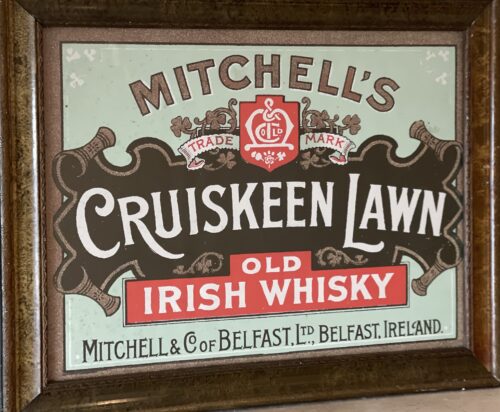
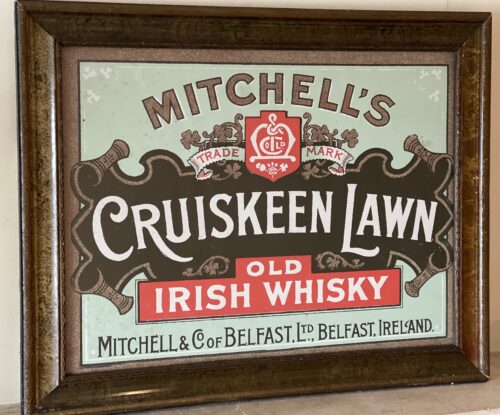 Mitchells Cruiskeen Lawn Old Irish Whiskey Advert. 48cm x 60cm Coleraine Co Antrim Once a giant of the distilling business along with Dunvilles,Mitchell’s fall from grace, like so many other superb Irish distilleries was symptomatic of the economic climate and circumstances of the time. Charles William Mitchell originated from Scotland and took over his fathers distillery in the Campletown area .In the 1860s he moved to Belfast and became manager of Dunvilles Whiskey before establishing his own brand Mitchell & Co tomb St in the late 1860s.A newspaper report in 1895 hailed the virtues of Mitchells Cruiskeen Lawn Whisky,which secured prizes around the world including first place at the New Orleans Exposition.It was a rare Mitchells Cruiskeen Lawn Whiskey mirror that recently commanded £11500 at auction in 2018 following the sale of the contents of an old Donegal public house. Indeed Mitchell’s were renowned for advertising their products on mirrors, trade cards, minature atlas books and pottery to name just a few. Below is the original mirror that was commissioned for their Tomb Street premises on the launch of their Cruiskeen Lawn Old Irish Whisky, late 1800’s. Two were made for the entrance of their Tomb Street premises. Inscribed is the Cruiskeen Lawn poem, with gold leaf barley with green and red in the Mitchell Crest. Definately the holy grail of all mirrors, a true treasure and still survives today in the heart of Belfast and worth the above mentioned princely sum and now probably more !
Mitchells Cruiskeen Lawn Old Irish Whiskey Advert. 48cm x 60cm Coleraine Co Antrim Once a giant of the distilling business along with Dunvilles,Mitchell’s fall from grace, like so many other superb Irish distilleries was symptomatic of the economic climate and circumstances of the time. Charles William Mitchell originated from Scotland and took over his fathers distillery in the Campletown area .In the 1860s he moved to Belfast and became manager of Dunvilles Whiskey before establishing his own brand Mitchell & Co tomb St in the late 1860s.A newspaper report in 1895 hailed the virtues of Mitchells Cruiskeen Lawn Whisky,which secured prizes around the world including first place at the New Orleans Exposition.It was a rare Mitchells Cruiskeen Lawn Whiskey mirror that recently commanded £11500 at auction in 2018 following the sale of the contents of an old Donegal public house. Indeed Mitchell’s were renowned for advertising their products on mirrors, trade cards, minature atlas books and pottery to name just a few. Below is the original mirror that was commissioned for their Tomb Street premises on the launch of their Cruiskeen Lawn Old Irish Whisky, late 1800’s. Two were made for the entrance of their Tomb Street premises. Inscribed is the Cruiskeen Lawn poem, with gold leaf barley with green and red in the Mitchell Crest. Definately the holy grail of all mirrors, a true treasure and still survives today in the heart of Belfast and worth the above mentioned princely sum and now probably more !









